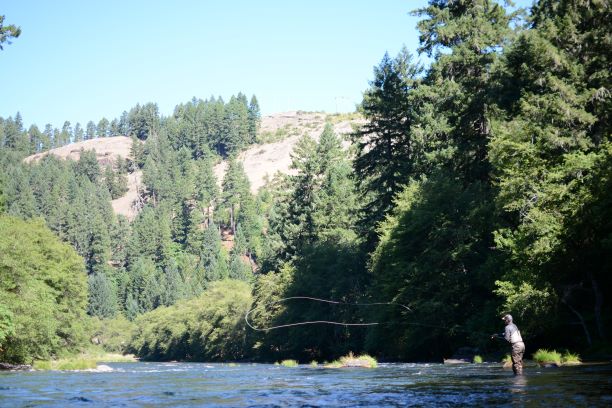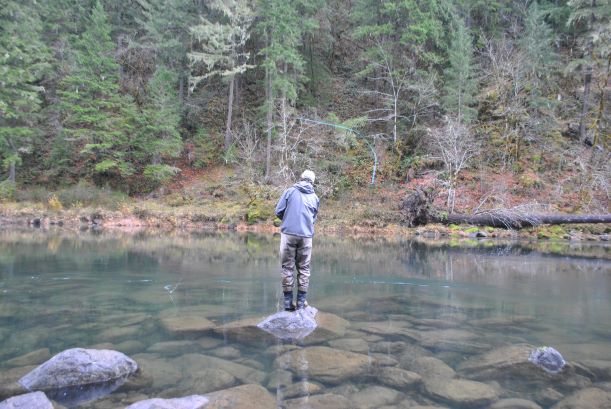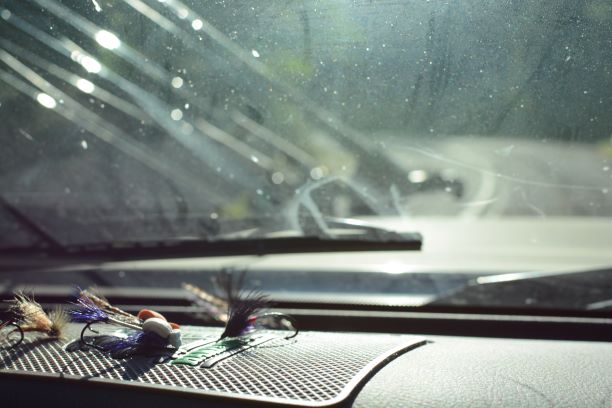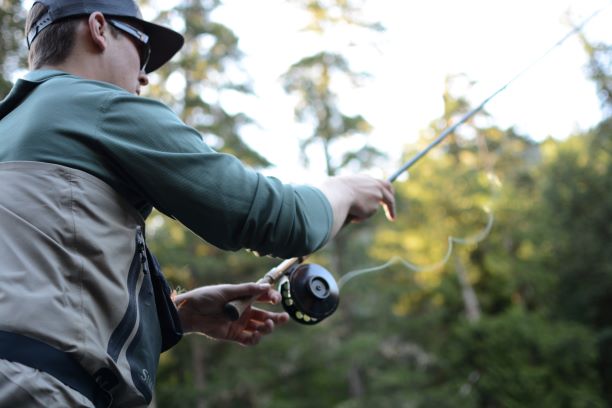
Image: Kyle Smith/Trout Unlimited.
It’s safe to say, our very own WSU director, Dean Finnerty, knows a thing or two about catching steelhead, especially on his home river, the North Umpqua. Dean’s stories of such pursuits are a dime a dozen, but we wanted to share some of his tips that are sure to make you a more successful angler. Trust us, this read will be worth your time.
You can repay us for supplying these gems of fishy wisdom by lending a hand to help conserve our incredible fisheries like that on the North Umpqua.
Enjoy – and make sure to tag us in your pics when this guide gives you success!
Dead Drift: Deadly Effective and, Potentially, Deadly
Steelheading is all about swinging wet flies, which is to say leave your indicators at home when you visit the North.
Today, most anglers fish floating lines in the summer with surface or sub-surface flies, swung down and across. For the winter run, anglers switch over to sinking lines and weighted flies, but it’s still the tried and true, wet fly swing.
For those readers new to steelhead fly fishing, there are really two techniques. One involves “dead drifting” nymph or egg-type patterns on or near the bottom. Deadly effective for sure. Add a strike indicator and a bead and it’s an amazingly effective way to catch steelhead. Fish from a boat and now it’s just plain ridiculous how easy and effective this method is. In the past, I’ve done it myself and I know a number of people on the Umpqua who still employ this “side-drifting drifting “technique down in the “gear water “section of the river. During the winter run it’s not too uncommon to rack up “double digit” days; even 30, 40 and 50steelhead a day can be caught using this method.

Image: Kyle Smith/Trout Unlimited.
A hard-fought regulation in the Umpqua Basin requires that all nonclipped adipose fin steelhead be “released unharmed”. While having double-digit days on steelhead is a lot of fun, I often wonder how many of the native steelhead destined for the spawning areas in the upper basin are accidentally injured using this technique and never make it.
Wet Fly Swing: the Tried and True
The second fly fishing technique is called the “wet fly swing.” Once you’ve had a steelhead grab a fly on a tight line during the swing and go deep into your backing, you’ll understand how so many lives are ruined, marriages failed and “real” jobs lost, all in pursuit of getting that “fix” again and again!
I’ve often argued with my gear fishing buddies (and have announced during more than one presentation at various sports shows) that a steel header armed with a modern spay outfit, using the systematic and methodic approach I’m about to reveal, fishing the waters that I’m about to describe, can out-fish the average, bank-bound, gear angler. “Blasphemy, heresy, you’re CRAZY Finnerty, utter non-sense!”
Steelhead Love Structure
Hear me out…Steelhead LOVE structure — boulders, ledges, logs, current seams, foam lines and tail outs. Steelhead also love water that is two to five feet deep with a modest current speed. I describe the speed generally as a “walking speed.” Yes, there are many exceptions but, as a rule, if come to a place I’ve never fished beforehand I see these characteristics, I’ll fish with total confidence and frequently find steelhead more than willing to eat my fly. Runs with lots of structure are more difficult to fish with conventional drift fishing tackle. Snags are more frequent, as is loss of gear, re-tying of terminal tackle, etc.
Additionally, most anglers don’t fish a run with a systematic approach that thoroughly covers the water. Casts are made kind of “shotgun” style … 50 feet that direction, 40 feet over there, 100 feet down towards the bottom of the pool…you get my drift (pun intended). Today’s modern spey rods and the amazingly versatile lines that have been designed over the past 15 years give you the ability to easily and effectively cover the water I described above, like never before.
Skate it ‘Til you Make it + Other Winners for your Box
In the summer months, 95 percent of the time I fish with a full floating line, 10 to 15 feet of tapered leader and a fly designed to stay on the surface and create a V-wake as it “skates” across the surface.

Image: Kyle Smith/Trout Unlimited.
These flies are known as “skaters” and examples range from traditional Atlantic salmon patterns like “Bombers” and “Moose Turds” to more modern designs that incorporate a foam “shellback”.
The goal is to keep the fly on the surface, under tension as it “skates” down and across, bringing steelhead up to the surface to eat it. Super exciting!
Other frequently used summer patterns are traditional hair or feather wing “attractor” type patterns. Examples of these include MOAL leaches, Skunks, Silver Hiltons and host of others that are fished just beneath the surface (1 to 3 inches). Still a very visual way to fish and super exciting because you’ll frequently see the fish come to the fly, grab it, and as they leave, a boil the size of wash tub appears and your rod is nearly jerked from your grasp!
Drop It Down in the Winter
In the winter months, I switch over to a sinking line system and a weighted fly that allows my presentation to work just above the structure that steelhead are so fond of. This keeps me in the “zone,” allowing the presentation to hang in front of a cold-blooded, frequently lethargic steelhead long enough to entice a strike. If my line or fly sinks too fast and I’m hitting the structure, I simply change the angle of my cast to prevent it from sinking so quickly, change the fly to one that’s not weighted as much, or change out the sinking portion of my line (usually just a sink-tip).
Let’s Talk About Approach, Baby
Both my summer approach and winter approach are the same. I start at the top of the run. If I know I’m the first one down that particular run that day, I start out with a short line, usually about a rod length.
I aim my cast across the current at a 90-degree angle, sometimes even slightly downstream. I allow the fly to swing under tension down and across current, directing the line’s speed with the rod tip until the fly ends its swing below me.
If I see a fish come to the fly but not take it, I feel a tug or see a boil or flash near the fly, I simply repeat the same cast (length and angle) again. Sometimes, (I honestly think way more often than we know) steelhead will miss a fly on the first pass, but if given a second or third opportunity, may successfully take the fly.

Image: Kyle Smith/Trout Unlimited.
If nothing happens during the presentation, I add two or three feet of line to my next cast. Let the fly swing across until it stops below me, again following the line’s speed with the rod tip. If you notice a downstream belly forming in your line as the swing comes across, simply mend the line by gently and carefully removing the portion of the line that is starting to belly and replacing it back on the water with an upstream movement of the rod.
Don’t be Spooky
Once you’ve covered the “close-in” water near the bank, you can begin to step into the water and begin wading out a bit. Steelhead are like every other lazy cow; they don’t want to work any harder than they have to.
Migrating steelhead travelling up river in low-light or during darkness, are frequently found holding close to shore, especially in winter flows. So, if you’re the first one to fish a run, avoid spooking fish and always start out with a short line if you can.
Wash, Rinse, Repeat
I continue this process: cast, swing, mend, add more line in two- to three-foot increments until I’m casting my comfortable distance, or my casts are covering across the run. Once I’ve reached this distance, then I proceed down the run by making my cast, letting the fly swing across the run under tension, adding needed mends until the swing ends below me. Then I simply take a couple of steps downstream and with the same amount of line out from the previous cast, make another cast across current. Cast, swing, mend, step, repeat. Cast, swing, mend, step and repeat all the way down the run, making sure to fully cover the tail out.
What have we done? We’ve started short, gradually and systematically increased our length of line and the concentric arcs (swings) down and across in a very rhythmic manner. We have literally covered every square foot of that run. Any steelhead in that run will have had a chance to see this fly come closer, and closer and closer until it either ignores the fly and allows it to pass their lie, or they’ve taken it.
Rhythm: Beats the ‘Picky Eater’ Reputation
What makes a cold-blooded animal—that isn’t required by nature to feed while they are on their spawning run—actually grab our bait, lure or flies? Steelhead aren’t even producing the digestive enzymes needed to digest food organisms if they were to eat something after leaving the salt and entering freshwater. We humans come up with theories—maybe they’re territorial, curious, playful, or aggressive. But no one can say for sure.
Over the years I’ve guided anglers on the North Umpqua, I’ve had hundreds of occasions to spot fish from the road. I often send my anglers down to the pool while I stay in position to watch the fish. Many, many times I’ve watched steelhead behavior as my folks begin to bring the fly toward the fish. Frequently, if the fish is going to take the fly, I can predict it with pretty fair accuracy.

Image: Kyle Smith/Trout Unlimited.
Steelhead have incredible eyesight and can spot a fly approaching from a long distance, perhaps as far as 20 feet in clear water conditions. When the fish spots the fly, if it’s going to be a player, almost always it will show some kind of physiological response. Sometimes they’ll move up towards the fly and then drop back to their lie as it passes. Sometimes their mouth, gills or pectoral fins will move quickly.
If the angler can keep a rhythmic cadence and downstream progression of each new swing of the fly until it gets within two to four feet from the fish, they’ll grab it. It’s almost as if the fish sees the fly coming closer and closer and gets really fired up about that fly. Then it just pounces!
Unfortunately, for many anglers, that rhythmic cadence gets broken by a bad cast, the fly getting hung up in stream side brush, something that causes a break in that steady downstream progression and it’s like flipping a switch, the steelhead loses interest.
I’ve also seen many times where steelhead move for a fly and, for some reason, at the very last moment they turn away. I’ve no idea why. Sometimes a change in fly pattern, retrieving 10 or 15 feet of line and working back down to the fish, or both, will bring the fish back.
I know if you fish in a systematic, rhythmic fashion and show the steelhead a fly coming closer and closer in a predictable manner, they’ll eat your fly.
Give Their Habitat Some Love
The North Umpqua is one of our country’s greatest natural resources. Anglers from around the world come every season to test their skills on the North Umpqua and their tourist dollars help keep local businesses afloat. We need to walk in the steps of previous visionaries and conservation legends like Frank and Jeanne Moore to protect and properly manage the North Umpqua’s runs of native steelhead for future generations.

Please consider lending your voice and joining other passionate anglers for every opportunity to protect wild steelhead wherever they exist, especially in places like Oregon’s North Umpqua River.
Right now, communities in this region are facing the aftermath of an intense wildfire season. Read what our Oregon Field Coordinator, Kyle Smith, shared in a blog post from last week, including a few resources of how you can help the communities impacted by wildfire in Oregon


